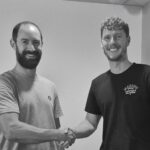As part of our team member profile series we’d like to introduce you to Marc Zablotny. Marc is part of a team of Resource Management Planners at Cuttriss Consultants, working closely alongside our surveyors and engineers. Planning is an interesting profession and Marc prepares resource consent applications for a variety of residential, commercial and subdivision proposals.
Planners can work in cities, suburbs, towns and even remote islands. They may specialise in areas such as: urban design, heritage, transportation or rural environments. Find out more at the NZ Planning Institute, who have over 2000 members.
Marc Zablotny began his planning career in Cheshire, England, before heading to Australia to see what the southern hemisphere had to offer. New Zealand beckoned and Marc joined Cuttriss Consultants as a planner in 2018. Marc is based at the Lower Hutt office and after a daily requisite cup of tea, enjoys contributing to shaping our urban environment.
Marc is also a Chartered Member of the Royal Town Planning Institute (U.K) and an Associate Member of the New Zealand Planning Institute.
We asked Marc some questions for an insight into a planner’s world
What is your role at Cuttriss?
My primary role is to prepare resource consent applications for a variety of residential, commercial and subdivision proposals. The process for this varies, but typically involves liaison with Council planners, architects, landscape designers and traffic engineers, as well as our own in-house surveyors and engineers. We all work towards creating a proposal that best conforms with the Council’s rules and our client’s vision.
Occasionally, if I’m lucky (or unlucky – I haven’t decided), I get to pop out into the field and help our surveying team as a survey assistant.
What projects are you working on?
The majority of my workload consists of preparing applications for residential developments and subdivisions across the Greater Wellington area, each with their own quirks and challenges. I find it genuinely interesting to contribute towards shaping our urban environment. Every now and again something truly weird and wonderful comes through the door.
Throughout my planning career I’ve been chased by cows, undertaken public consultation with a dog, visited a site in a golf buggy, forced into transcendental meditation and played hide and seek with some chickens, among other things.
What do you enjoy about being a planner at Cuttriss?
We have a reasonably flat working structure within the planning team, so I have plenty of opportunities to take the lead on different projects and develop my decision-making and management skills. Working alongside our surveyors and engineers is hugely beneficial too. I have learned so much more about the different facets to land development than I would in a purely planning environment.
What inspired you to become a planner?
You’ll meet very few people who dreamed of becoming a planner since they were a child! I was originally on track to becoming a journalist, but very much stumbled upon the planning field through my general interest in geography. I quickly realised that it ticked all the boxes in what I wanted out a career, and I haven’t looked back since.
Where did you study and what qualifications do you have?
I have a Master’s degree from the University of Sheffield, which has one of the U.K’s best planning schools and is a member of the prestigious Russell Group. I’m also a Chartered Member of the Royal Town Planning Institute and currently a Young Member of the Resource Management Law Association and Associate Member of the New Zealand Planning Institute.
What was your career path leading to Cuttriss and how does working in New Zealand compare to the U.K?
After graduating, I worked for a strategic land promoter in the north of England, helping to secure consent for large-scale housing developments across the country. In 2017 I decided I was sick of the bad weather and Brexit and moved to Australia. Following a couple of contract planning roles in Sydney and Melbourne, I found myself here in New Zealand!
I’m fortunate to have worked within a number of different planning systems. New Zealand’s is quite similar to the U.K as they’re based on the same underlying principles. I think the system for obtaining a neighbour’s consent for a proposal is fantastic. It’d never work in England though because we like complaining too much.
What does a typical day look like for you?
Nothing starts until I’ve had a cup of tea. You have to steep it for at least five minutes, otherwise it’s too weak and you don’t get the full leaf-infusion or the caffeine hit. Milk comes post-teabag removal, never before. Only add a drop of milk, otherwise all that steeping will have been for nothing. Then it’s on to project work.
What are the key strengths/skills needed to become a planner?
When it comes to planning, the devil is always in the detail, be it in relation to a set of architectural plans or within District Plan policies and rules. Diligence will take you a long way! People are very passionate about matters that influence them and their community, so it pays to be able to keep a level head, be empathetic and able to communicate things clearly.
What advice do you have for anyone considering working in your industry?
Planning is something of a jack-of-all trades career. Often you will be juggling architectural, traffic, heritage, ecological and flooding considerations all at once. This can get overwhelming. It’s important to remember that this is a highly collaborative industry where expert support and educational resources are all around you, so help is always at hand.
It can be easy to get grand ideas of how you’ll transform your neighbourhood or city as a planner. In reality, this may not happen as fast or as obviously as you expect, but it’s key to remember that every successful project is a step towards positive change.
At Cuttriss, a planning career can be very rewarding. Learn more about careers at Cuttriss or contact us for more information. Our experienced planners have the expertise to successfully navigate council consent processes, to give projects the greatest chance of success.




